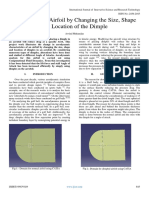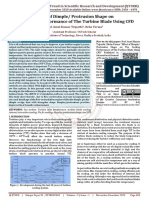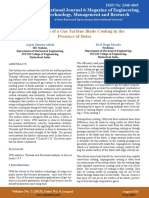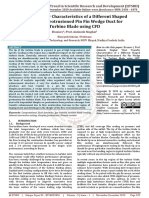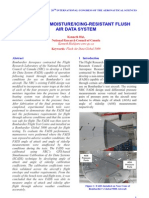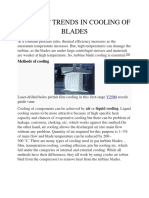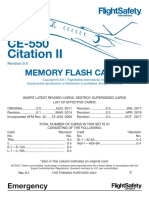Professional Documents
Culture Documents
Analysis of Thermal ICE Protection Using Piccolo Tube
Copyright
Available Formats
Share this document
Did you find this document useful?
Is this content inappropriate?
Report this DocumentCopyright:
Available Formats
Analysis of Thermal ICE Protection Using Piccolo Tube
Copyright:
Available Formats
Volume 2, Issue 8, August 2017 International Journal of Innovative Science and Research Technology
ISSN No: - 2456 2165
Analysis of Thermal ICE Protection Using Piccolo
Tube
Karan Jain, Willy Warghese, Rohith Thangirala
Department of Aerospace
SRM University, Chennai(INDIA)
Abstract- In-flight icing is a major concern in aircraft aircraft nose and fuselage. Even a small ice formation on the
safety and a non-negligible source of incidents and wing leading edge would cause decrease in lift and decrease in
accidents, and is still a serious hazard today. It remains drag force .The various systems to avoid ice formations are
consequently a design and certification challenge for based on mechanical, chemical and thermal techniques. The
aircraft manufacturers. The aerodynamic performance of bleed air technique is the most popular in the aircraft industry.
an aircraft can indeed degrade rapidly when flying in icing A piccolo tube with a series of in line staggered holes is
conditions, leading to accidents. In-flight icing occurs when placed inside the leading end near to its inner surface. The hot
an aircraft passes through clouds containing super cooled bleed air from the engine compressor is passed through the
water droplets at or below freezing temperature. Droplets piccolo tube and it ejects from the piccolo tube holes in the
impinge on its exposed surfaces and freeze, causing form of high velocity jets that impinge on the inner surface to
roughness and shape changes that increase drag, decrease outer surface maintaining the wing leading edge hot enough to
lift and reduce the stall angle of attack, eventually avoid accretion of ice.
inducing flow separation and stall. This hazardous ice
accretion is prevented by the use of dedicated anti-icing On the other hand Icing wing tunnel testing is costly and
systems, among which hot- air-types are the most common limiting. Both these cases are suitable for analyzing a system
for aircraft. A widely used method in aviation Industry to but can hardly be used for design platform. Therefore, it is
overcome this problem is to employ a Hot-Air Anti-icing logical to benefit from CFD model to optimize anti icing
system owing to its simplicity, efficiency and reliability. systems before they are tested. Nevertheless fully coupled 3D
High temperature, hig pressure air from the engine stimulations are quite demanding in terms of computing
compressor is extracted and passed through a piccolo tube, resources.
and the distance between piccolo tube and wing inner
surface have strong influence on keeping the external
surface of the wing leading edge sufficiently hot to avoid II. EXPERIMENTAL METHODOLOGY
ice formation. In the present work, anti-icing scheme for a
typical aircraft wing of an airfoil shape, involving effect of
hot air jets from a piccolo tube, is investigated NACA 2412 airfoil was used for wing section. The profile was
numerically. The CAD model of the wing-piccolo tube decline with maximum camber of 2%chord length, maximum
assembly is generated using CATIA software and camber position at 40% chord length and maximum thickness
discretisation of the flow domain is being done using of 12% chord length a chord length of 1.5 m was selected. The
ANSYS software. wing leading edge was equipped with a bleed air system
consisting of a piccolo tube. The heated region extended to
I. INTRODUCTION 12% of chord on both upper surfaces. The piccolo tube had an
outer diameter of 22mm. The diameter jet hole was 9mm and
the spacing between adjacent holes was 7mm.
Design of the aircraft bleed-air ice protection systems involves
optimization of multiple geometric and flow of parameters
under constraints such as a system weight and bleed air
availability from the power plant at various flight regimes.
Geometric design parameters that have sufficient impact on
the bleed air ice protection system performance include airfoil
section, diffused shape, number of piccolo tube hole diameter,
hole pitch, hole circumferential parameter and hole pattern.
Ice formation on an aircraft structure occurs over the leading
edge of aircraft wings, lip of the intake duct and also on the
IJISRT17AG70 www.ijisrt.com 148
Volume 2, Issue 8, August 2017 International Journal of Innovative Science and Research Technology
ISSN No: - 2456 2165
III. EXPERIMENTAL RESULTS
AND DISCUSSION
Case1-Hot air jets coming out of the piccolo tube arrangement
at -45 D to 45 Degree. The accelerated flow subsequently
lowered the static temperature and increased the cooling effect
on the upper surface. The hot ir from piccolo tube impinged
on the wing skin and circulated inside the diffuser region
before leaving through the upper and lower diffuser passages
formed between the inner liner and the wing skin.
Case 2-Hot air jets coming out of piccolo tube arrangement at
centre 0 degree. The temperature distribution along either side
of the chord line is more inform and the results appear to be
better and efficient when compared to case 1. Analysis results
it is evident that case 2 piccolo tube and wing inner surface
gives favorable temperature distribution on the outer surface
of the wing and the surface is sufficiently high to avoid ice
formation under flight condition.
Fig. 1.
Fig. 3.
IV. CONCLUSION
In case 1 temperature distribution was not that sufficient and
effective for removal of ice. From analysis it is found that in
case 1 maximum temperature distribution was 225k but
Fig. 2. overall temperature around the span was found to be 175k and
minimum temperature was 35k. But in case 2 maximum
IJISRT17AG70 www.ijisrt.com 149
Volume 2, Issue 8, August 2017 International Journal of Innovative Science and Research Technology
ISSN No: - 2456 2165
temperature was 375k and minimum temperature was 25k and
this temperature is sufficient for ice removal.
REFERENCES
[1]. FAA Information for Operators 09005.
[2]. http://www.compositesworld.com/articles/787-
integrates-new-composite-wing-deicing-system.
[3]. http://www.boeing.com/commercial/aeromagazine/articl
es/qtr_4_07/article_02_4.html.
[4]. http://papers.sae.org/2009-01-3165/ | Capitalizing on the
Increased Flexibility that Comes from High Power
Density Electrothermal Deicing.
[5]. "How They Work: Ice Protection Systems". Aviation
Week. 2010.
[6]. "Electro- mechanical Deicing". Air & Space Magazine.
2004.
[7]. "CUTAWAY: P-8A Poseidon - A Boeing with boost of
bravado". Flight International. 2010.
IJISRT17AG70 www.ijisrt.com 150
You might also like
- Citation Jet 1 - Pilot Training Manual - C525 (Vol 1)Document383 pagesCitation Jet 1 - Pilot Training Manual - C525 (Vol 1)Andy88% (8)
- CJ3 PTMDocument787 pagesCJ3 PTMPhil Marsh93% (14)
- Simulate Piccolo Tube Anti-Icing System with CFDDocument7 pagesSimulate Piccolo Tube Anti-Icing System with CFDsanjoshi21No ratings yet
- Solar Mars 100 Gas TurbineDocument92 pagesSolar Mars 100 Gas Turbinechdi67% (3)
- Chapter 29 PDFDocument2,267 pagesChapter 29 PDFAmjad Salam100% (1)
- Air Conditioning LiebheerDocument298 pagesAir Conditioning Liebheerdiasfm100% (2)
- CRJ 700 Systems FlashcardsDocument146 pagesCRJ 700 Systems FlashcardsAnish Shakya100% (1)
- Numerical Analysis and Comparison of Film Cooling and Convective Cooling For Turbojet Engine ApplicationDocument4 pagesNumerical Analysis and Comparison of Film Cooling and Convective Cooling For Turbojet Engine Applicationkishore pmNo ratings yet
- Gas turbine blade cooling techniques overviewDocument11 pagesGas turbine blade cooling techniques overviewBadr BouananeNo ratings yet
- Analysis of An Airfoil by Changing The Size, Shape and Location of The DimpleDocument25 pagesAnalysis of An Airfoil by Changing The Size, Shape and Location of The DimpleInternational Journal of Innovative Science and Research Technology100% (1)
- Effect of Dimple Protrusion Shape On The Cooling Performance of The Turbine Blade Using CFDDocument8 pagesEffect of Dimple Protrusion Shape On The Cooling Performance of The Turbine Blade Using CFDEditor IJTSRDNo ratings yet
- Review of Air and Liquid Metal Based Cooling of Turbine BladesDocument7 pagesReview of Air and Liquid Metal Based Cooling of Turbine BladesAirwarriorg91No ratings yet
- Air-Cooling Influence on Wire Arc Additive Manufactured SurfacesDocument7 pagesAir-Cooling Influence on Wire Arc Additive Manufactured SurfacesFlavio Emanuel de Lima SilvaNo ratings yet
- Zhang 2020 Review Film Cooling EnhancementDocument18 pagesZhang 2020 Review Film Cooling Enhancement안정수No ratings yet
- A Review Paper On Gas Turbine Blade Cooling MethodsDocument6 pagesA Review Paper On Gas Turbine Blade Cooling MethodsEditor IJTSRDNo ratings yet
- Fin Irjmets1652381830Document4 pagesFin Irjmets1652381830ajay1mk2No ratings yet
- Analysis The Enhancement of Heat Transfer Rate in Heat Pipe With Various Wick Materials For Effective Utilization of Waste Heat in IndustriesDocument9 pagesAnalysis The Enhancement of Heat Transfer Rate in Heat Pipe With Various Wick Materials For Effective Utilization of Waste Heat in IndustriesIJRASETPublicationsNo ratings yet
- Review On Analysis and Design of RCC Cooling Tower Using STAAD-ProDocument7 pagesReview On Analysis and Design of RCC Cooling Tower Using STAAD-ProIJRASETPublicationsNo ratings yet
- Analysis of Ice Formation Over An Aircraft WingDocument9 pagesAnalysis of Ice Formation Over An Aircraft WingNambi RajanNo ratings yet
- Aerospace: Numerical Simulation of The Anti-Icing Performance of Electric Heaters For Icing On The NACA 0012 AirfoilDocument15 pagesAerospace: Numerical Simulation of The Anti-Icing Performance of Electric Heaters For Icing On The NACA 0012 AirfoilNaveen NaviNo ratings yet
- CFD Analysis of A Gas Turbine Blade Cooling in The Presence of HolesDocument11 pagesCFD Analysis of A Gas Turbine Blade Cooling in The Presence of HolesShivam KumarNo ratings yet
- J Ijheatmasstransfer 2016 12 014Document12 pagesJ Ijheatmasstransfer 2016 12 014Long ZeNo ratings yet
- A Direct Evaporative Cooler Operating in MaharashtraDocument5 pagesA Direct Evaporative Cooler Operating in Maharashtrapaween saetaeNo ratings yet
- 30 CFD AnalysisDocument7 pages30 CFD AnalysisNikit VhatkarNo ratings yet
- Design and Development of Solar Powered 360degree Automatic Air CoolerDocument6 pagesDesign and Development of Solar Powered 360degree Automatic Air CoolerIJRASETPublicationsNo ratings yet
- CFD Analysis of An IC Engine With and Without GrooveDocument12 pagesCFD Analysis of An IC Engine With and Without GrooveIJRASETPublicationsNo ratings yet
- Heat Transfer Characteristics of A Different Shaped Dimpled Protrusioned Pin Fin Wedge Duct For Turbine Blade Using CFDDocument13 pagesHeat Transfer Characteristics of A Different Shaped Dimpled Protrusioned Pin Fin Wedge Duct For Turbine Blade Using CFDEditor IJTSRDNo ratings yet
- Turbine Blade Film Cooling Research ReviewDocument21 pagesTurbine Blade Film Cooling Research ReviewSaroz ParajuliNo ratings yet
- Numerical SimulationDocument12 pagesNumerical SimulationLearn With SidNo ratings yet
- Steady and Transient Analysis of Engine Cylinder Head With Fins at 3000C and 5000CDocument11 pagesSteady and Transient Analysis of Engine Cylinder Head With Fins at 3000C and 5000CIJRASETPublicationsNo ratings yet
- Thermal Analysis of Composite Steam Turbine BladesDocument6 pagesThermal Analysis of Composite Steam Turbine BladesInternational Journal of Innovative Science and Research TechnologyNo ratings yet
- PrecisionAir ConditioningDocument11 pagesPrecisionAir ConditioningAzmi PatarNo ratings yet
- Design of I.C.Engine Air Cooling Fins Using Fea AnalysisDocument13 pagesDesign of I.C.Engine Air Cooling Fins Using Fea Analysisijire publicationNo ratings yet
- Performance_Study_of_Portable_Semiconductor_RefrigDocument17 pagesPerformance_Study_of_Portable_Semiconductor_RefrigMd Shah JamanNo ratings yet
- 1 s2.0 S2214785322035441 MainDocument7 pages1 s2.0 S2214785322035441 MainMohammad Irfan AliNo ratings yet
- Innovative Moisture/Icing-Resistant Flush Air Data System: Kenneth Hui, National Research Council of CanadaDocument10 pagesInnovative Moisture/Icing-Resistant Flush Air Data System: Kenneth Hui, National Research Council of Canadabxlmichael8837No ratings yet
- Review Enhancement of Heat Transfer Through Modification in FinsDocument9 pagesReview Enhancement of Heat Transfer Through Modification in FinsIJRASETPublicationsNo ratings yet
- Results in Physics: Sun Je Kim, Yeong Ryeon Kim, Yongha Kim, Myung Ho Kim, Myungsup LeeDocument9 pagesResults in Physics: Sun Je Kim, Yeong Ryeon Kim, Yongha Kim, Myung Ho Kim, Myungsup LeeCarlos VegaNo ratings yet
- Air Conditioner Using Peltier ModuleDocument7 pagesAir Conditioner Using Peltier Modulekadamarya2005No ratings yet
- Aircraft Anti-Icing SystemDocument3 pagesAircraft Anti-Icing SystemVejay RamNo ratings yet
- Cooling Load Calculation of New Academic Building of Asansol Engineering CollegeDocument5 pagesCooling Load Calculation of New Academic Building of Asansol Engineering CollegeRaj KhanNo ratings yet
- A Recent Application of Advanced Cooling Technology To Improve High-Strength Plate Steel ProductionDocument8 pagesA Recent Application of Advanced Cooling Technology To Improve High-Strength Plate Steel ProductionJJNo ratings yet
- Unsteady Thermodynamic CFD Simulations of Aircraft Wing Anti-Icing OperationDocument19 pagesUnsteady Thermodynamic CFD Simulations of Aircraft Wing Anti-Icing OperationnuazzNo ratings yet
- Air Conditioner Using Peltier ModuleDocument6 pagesAir Conditioner Using Peltier ModuleMuhammad AtifNo ratings yet
- Marine AC CalculationDocument10 pagesMarine AC CalculationPratikno SajaNo ratings yet
- Coaling Load HVAC PDFDocument10 pagesCoaling Load HVAC PDFIntan Luruh LarasatiNo ratings yet
- 10 1016@j Solener 2020 04 083Document9 pages10 1016@j Solener 2020 04 083Sirine SaidiNo ratings yet
- Improve Heat Resistance of Composite Engine Cowlings Using Ceramic Coating Materials, Experimental Design and TestingDocument11 pagesImprove Heat Resistance of Composite Engine Cowlings Using Ceramic Coating Materials, Experimental Design and TestingmeracarrNo ratings yet
- Designing of Air Conditioner System For College LaboratoryDocument7 pagesDesigning of Air Conditioner System For College LaboratoryMarc Emil CasilaoNo ratings yet
- Heat Transfer and Friction in Rectangular Duct With Pin-Fin ArraysDocument7 pagesHeat Transfer and Friction in Rectangular Duct With Pin-Fin ArraysEmmanuel Ber SNo ratings yet
- Turbine Blade Cooling MethodsDocument4 pagesTurbine Blade Cooling MethodsNah Sr AdNo ratings yet
- Heat TransferDocument5 pagesHeat TransferJournalNX - a Multidisciplinary Peer Reviewed JournalNo ratings yet
- Anti-Ice IJRM 2020Document9 pagesAnti-Ice IJRM 2020Parthasarathi BeraNo ratings yet
- Aviation Accident Analysis: A Case Study: Advances in Intelligent Systems and Computing July 2018Document10 pagesAviation Accident Analysis: A Case Study: Advances in Intelligent Systems and Computing July 2018Umar Pathan PathanNo ratings yet
- Cooling System of High Power Synchronous GeneratorDocument5 pagesCooling System of High Power Synchronous GeneratorLorem53No ratings yet
- Experimental Analysis of Heat Transfer Performance of Wavy Fin Heat Sink With Different OrientationDocument5 pagesExperimental Analysis of Heat Transfer Performance of Wavy Fin Heat Sink With Different OrientationMADDI MADHAV.No ratings yet
- Effectiveness of Air CoolerDocument12 pagesEffectiveness of Air Coolerdhestyana.oemarNo ratings yet
- Ijetae Ncetet 2018 01Document2 pagesIjetae Ncetet 2018 01Ajaysinh SolankiNo ratings yet
- File ServeDocument7 pagesFile ServeVignesh KrishNo ratings yet
- Thesis Refrigeration and Air Conditioning PDFDocument5 pagesThesis Refrigeration and Air Conditioning PDFaprilbellhartford100% (3)
- Heat Transfer Analysis of A Cold PlateDocument13 pagesHeat Transfer Analysis of A Cold PlateManisha Hitesh BansalNo ratings yet
- 21-spjmr-599 Pun FDocument5 pages21-spjmr-599 Pun FNathar ShaNo ratings yet
- Current Trends in Cooling of BladesDocument8 pagesCurrent Trends in Cooling of BladesPRAVEENNo ratings yet
- Solar Air Heater Integrated With Different Shaped Turbulators A ReviewDocument6 pagesSolar Air Heater Integrated With Different Shaped Turbulators A ReviewEditor IJTSRDNo ratings yet
- 10 VII July 2022Document20 pages10 VII July 2022IJRASETPublicationsNo ratings yet
- Warm Air Heating: International Series of Monographs in Heating, Ventilation and RefrigerationFrom EverandWarm Air Heating: International Series of Monographs in Heating, Ventilation and RefrigerationNo ratings yet
- Formulation and Evaluation of Poly Herbal Body ScrubDocument6 pagesFormulation and Evaluation of Poly Herbal Body ScrubInternational Journal of Innovative Science and Research TechnologyNo ratings yet
- Comparatively Design and Analyze Elevated Rectangular Water Reservoir with and without Bracing for Different Stagging HeightDocument4 pagesComparatively Design and Analyze Elevated Rectangular Water Reservoir with and without Bracing for Different Stagging HeightInternational Journal of Innovative Science and Research TechnologyNo ratings yet
- Explorning the Role of Machine Learning in Enhancing Cloud SecurityDocument5 pagesExplorning the Role of Machine Learning in Enhancing Cloud SecurityInternational Journal of Innovative Science and Research TechnologyNo ratings yet
- A Review: Pink Eye Outbreak in IndiaDocument3 pagesA Review: Pink Eye Outbreak in IndiaInternational Journal of Innovative Science and Research TechnologyNo ratings yet
- Design, Development and Evaluation of Methi-Shikakai Herbal ShampooDocument8 pagesDesign, Development and Evaluation of Methi-Shikakai Herbal ShampooInternational Journal of Innovative Science and Research Technology100% (2)
- Studying the Situation and Proposing Some Basic Solutions to Improve Psychological Harmony Between Managerial Staff and Students of Medical Universities in Hanoi AreaDocument5 pagesStudying the Situation and Proposing Some Basic Solutions to Improve Psychological Harmony Between Managerial Staff and Students of Medical Universities in Hanoi AreaInternational Journal of Innovative Science and Research TechnologyNo ratings yet
- A Survey of the Plastic Waste used in Paving BlocksDocument4 pagesA Survey of the Plastic Waste used in Paving BlocksInternational Journal of Innovative Science and Research TechnologyNo ratings yet
- Electro-Optics Properties of Intact Cocoa Beans based on Near Infrared TechnologyDocument7 pagesElectro-Optics Properties of Intact Cocoa Beans based on Near Infrared TechnologyInternational Journal of Innovative Science and Research TechnologyNo ratings yet
- Auto Encoder Driven Hybrid Pipelines for Image Deblurring using NAFNETDocument6 pagesAuto Encoder Driven Hybrid Pipelines for Image Deblurring using NAFNETInternational Journal of Innovative Science and Research TechnologyNo ratings yet
- Cyberbullying: Legal and Ethical Implications, Challenges and Opportunities for Policy DevelopmentDocument7 pagesCyberbullying: Legal and Ethical Implications, Challenges and Opportunities for Policy DevelopmentInternational Journal of Innovative Science and Research TechnologyNo ratings yet
- Navigating Digitalization: AHP Insights for SMEs' Strategic TransformationDocument11 pagesNavigating Digitalization: AHP Insights for SMEs' Strategic TransformationInternational Journal of Innovative Science and Research TechnologyNo ratings yet
- Hepatic Portovenous Gas in a Young MaleDocument2 pagesHepatic Portovenous Gas in a Young MaleInternational Journal of Innovative Science and Research TechnologyNo ratings yet
- Review of Biomechanics in Footwear Design and Development: An Exploration of Key Concepts and InnovationsDocument5 pagesReview of Biomechanics in Footwear Design and Development: An Exploration of Key Concepts and InnovationsInternational Journal of Innovative Science and Research TechnologyNo ratings yet
- Automatic Power Factor ControllerDocument4 pagesAutomatic Power Factor ControllerInternational Journal of Innovative Science and Research TechnologyNo ratings yet
- Formation of New Technology in Automated Highway System in Peripheral HighwayDocument6 pagesFormation of New Technology in Automated Highway System in Peripheral HighwayInternational Journal of Innovative Science and Research TechnologyNo ratings yet
- Drug Dosage Control System Using Reinforcement LearningDocument8 pagesDrug Dosage Control System Using Reinforcement LearningInternational Journal of Innovative Science and Research TechnologyNo ratings yet
- The Effect of Time Variables as Predictors of Senior Secondary School Students' Mathematical Performance Department of Mathematics Education Freetown PolytechnicDocument7 pagesThe Effect of Time Variables as Predictors of Senior Secondary School Students' Mathematical Performance Department of Mathematics Education Freetown PolytechnicInternational Journal of Innovative Science and Research TechnologyNo ratings yet
- Mobile Distractions among Adolescents: Impact on Learning in the Aftermath of COVID-19 in IndiaDocument2 pagesMobile Distractions among Adolescents: Impact on Learning in the Aftermath of COVID-19 in IndiaInternational Journal of Innovative Science and Research TechnologyNo ratings yet
- Securing Document Exchange with Blockchain Technology: A New Paradigm for Information SharingDocument4 pagesSecuring Document Exchange with Blockchain Technology: A New Paradigm for Information SharingInternational Journal of Innovative Science and Research TechnologyNo ratings yet
- Perceived Impact of Active Pedagogy in Medical Students' Learning at the Faculty of Medicine and Pharmacy of CasablancaDocument5 pagesPerceived Impact of Active Pedagogy in Medical Students' Learning at the Faculty of Medicine and Pharmacy of CasablancaInternational Journal of Innovative Science and Research TechnologyNo ratings yet
- Intelligent Engines: Revolutionizing Manufacturing and Supply Chains with AIDocument14 pagesIntelligent Engines: Revolutionizing Manufacturing and Supply Chains with AIInternational Journal of Innovative Science and Research TechnologyNo ratings yet
- Enhancing the Strength of Concrete by Using Human Hairs as a FiberDocument3 pagesEnhancing the Strength of Concrete by Using Human Hairs as a FiberInternational Journal of Innovative Science and Research TechnologyNo ratings yet
- Exploring the Clinical Characteristics, Chromosomal Analysis, and Emotional and Social Considerations in Parents of Children with Down SyndromeDocument8 pagesExploring the Clinical Characteristics, Chromosomal Analysis, and Emotional and Social Considerations in Parents of Children with Down SyndromeInternational Journal of Innovative Science and Research TechnologyNo ratings yet
- Supply Chain 5.0: A Comprehensive Literature Review on Implications, Applications and ChallengesDocument11 pagesSupply Chain 5.0: A Comprehensive Literature Review on Implications, Applications and ChallengesInternational Journal of Innovative Science and Research TechnologyNo ratings yet
- Teachers' Perceptions about Distributed Leadership Practices in South Asia: A Case Study on Academic Activities in Government Colleges of BangladeshDocument7 pagesTeachers' Perceptions about Distributed Leadership Practices in South Asia: A Case Study on Academic Activities in Government Colleges of BangladeshInternational Journal of Innovative Science and Research TechnologyNo ratings yet
- Advancing Opthalmic Diagnostics: U-Net for Retinal Blood Vessel SegmentationDocument8 pagesAdvancing Opthalmic Diagnostics: U-Net for Retinal Blood Vessel SegmentationInternational Journal of Innovative Science and Research TechnologyNo ratings yet
- The Making of Self-Disposing Contactless Motion-Activated Trash Bin Using Ultrasonic SensorsDocument7 pagesThe Making of Self-Disposing Contactless Motion-Activated Trash Bin Using Ultrasonic SensorsInternational Journal of Innovative Science and Research TechnologyNo ratings yet
- Natural Peel-Off Mask Formulation and EvaluationDocument6 pagesNatural Peel-Off Mask Formulation and EvaluationInternational Journal of Innovative Science and Research TechnologyNo ratings yet
- Beyond Shelters: A Gendered Approach to Disaster Preparedness and Resilience in Urban CentersDocument6 pagesBeyond Shelters: A Gendered Approach to Disaster Preparedness and Resilience in Urban CentersInternational Journal of Innovative Science and Research TechnologyNo ratings yet
- Handling Disruptive Behaviors of Students in San Jose National High SchoolDocument5 pagesHandling Disruptive Behaviors of Students in San Jose National High SchoolInternational Journal of Innovative Science and Research TechnologyNo ratings yet
- Service Information Letter: Applicable: X Maintenance & Engineering Flight OperationsDocument37 pagesService Information Letter: Applicable: X Maintenance & Engineering Flight OperationsGian Nuñez RamosNo ratings yet
- IFly 744 TutorialDocument84 pagesIFly 744 Tutorialleopolman100% (1)
- Airbus Tech Course NotesDocument15 pagesAirbus Tech Course NotesRohit Rajput100% (1)
- King Air BE-200-B200 Flash Cards (H)Document486 pagesKing Air BE-200-B200 Flash Cards (H)Alejandro100% (5)
- MetroIII SystemsDocument66 pagesMetroIII Systemsmostrob100% (1)
- 216 PremidfinDocument22 pages216 PremidfinKenneth SubiaNo ratings yet
- Guia 695Document16 pagesGuia 695Elikaty Servicios AereosNo ratings yet
- TTM Single Aisle Line & Base Ata 30Document154 pagesTTM Single Aisle Line & Base Ata 30林至伟No ratings yet
- Airframe Stock ListDocument546 pagesAirframe Stock List2yp4sj97vcNo ratings yet
- ATA 44 - Cabin Systems (Mike Tooley)Document16 pagesATA 44 - Cabin Systems (Mike Tooley)Jagbir SinghNo ratings yet
- Rolls-Royce: 250-B17F Series Operation and MaintenanceDocument2 pagesRolls-Royce: 250-B17F Series Operation and MaintenanceAnonymous 298xlo3uUNo ratings yet
- Training Manual A 319/320/321: ATA 36 Pneumatic ATA 30-10 Wing Anti IceDocument42 pagesTraining Manual A 319/320/321: ATA 36 Pneumatic ATA 30-10 Wing Anti IceHENIGUEDRINo ratings yet
- Fault Isolation Manual: Print Date: 2021-05-27Document13 pagesFault Isolation Manual: Print Date: 2021-05-27Mahbub RahmanNo ratings yet
- 30 ATA ChapterDocument2 pages30 ATA ChapterŞevval YalınNo ratings yet
- ATA 21 - Air Conditioning and PressurizationDocument19 pagesATA 21 - Air Conditioning and PressurizationANIME TIMENo ratings yet
- Fault Isolation Manual: Print Date: 2021-05-27Document16 pagesFault Isolation Manual: Print Date: 2021-05-27Mahbub RahmanNo ratings yet
- Ata 36Document11 pagesAta 36jontis jasoliyaNo ratings yet
- Summary E190Document100 pagesSummary E190HUY HUNGNo ratings yet
- 09 - ATA 21 - 190 - 190pgDocument190 pages09 - ATA 21 - 190 - 190pgေအာင္ ရွင္း သန္ ့0% (1)
- ATA App B1900D Ground Run Check ListDocument67 pagesATA App B1900D Ground Run Check ListAnton Coetzer100% (1)
- Gulfstream GV Air Conditioning Systems GuideDocument23 pagesGulfstream GV Air Conditioning Systems GuideGourav DasNo ratings yet
- Flash Cards c550Document102 pagesFlash Cards c550Lucas Knight100% (4)
- ATA 71-80 Multiple Choice QuestionnaireDocument7 pagesATA 71-80 Multiple Choice QuestionnairePhạm Hà TiếnNo ratings yet
- A340-300 Type Training QustionsDocument35 pagesA340-300 Type Training Qustionsmajidsmsm12No ratings yet









